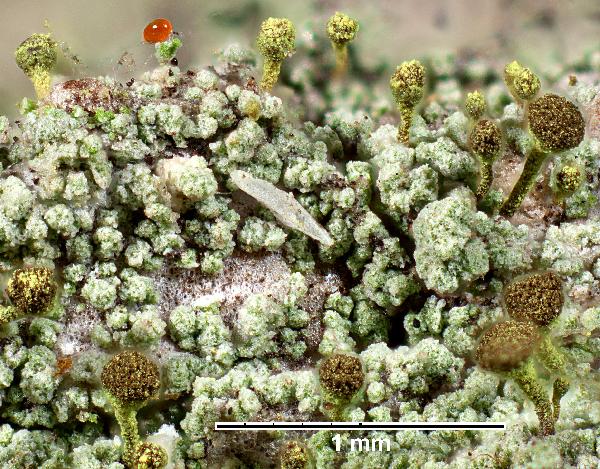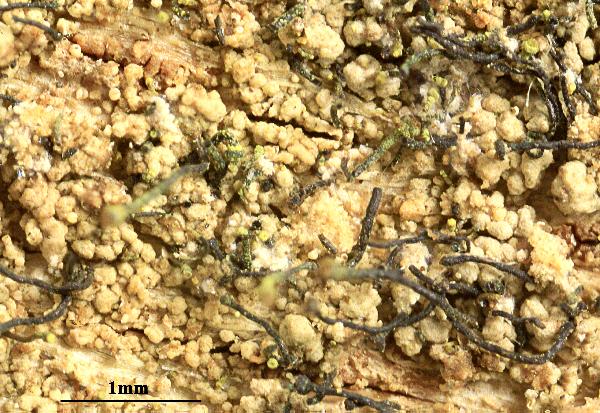Chaenotheca chlorella (Ach.) Müll. Arg.
Mém. Soc. Phys. Hist. Nat. Genève, 16: 360, 1862. Basionym: Calicium chlorellum Ach. - Meth. Lich.: 89, 1803.
Synonyms: Calicium phaeocephalum var. flavum Harm.; Chaenotheca carthusiae (Harm.) Lettau; Chaenotheca suzai Nádv.
Distribution: N - Frl (Puntillo & Puntillo 2009), Ven (Puntillo & Puntillo 2009), TAA (Nascimbene 2014, Nascimbene & Marini 2015, Trindade & al. 2021), Lomb (Puntillo & Puntillo 2009), Lig (Puntillo & Puntillo 2009). C - Tosc (Puntillo & Puntillo 2009), Sar (Puntillo & Puntillo 2009). S - Bas (Potenza & al. 2014), Cal (Puntillo 1994, 1996, Puntillo & Puntillo 2009).
Description: Thallus crustose, usually well-developed and episubstratic, ecorticate, verrucose to minutely granular, green to grey-green. Apothecia short-stalked, pin-like, shining black but covered in a bright yellow pruina at least in the upper part of stalk and the lower side of capitulum. Stalk 0.7-1 mm high, 0.05-0.08 mm thick, of periclinally arranged, medium brown hyphae. Capitulum broadly obovoid to lenticular, with a more or less well-developed excipulum of periclinally arranged hyphae, continuous with the stalk tissue. Mazaedium well-developed, brown; hypothecium medium brown, with a strongly convex upper surface. Asci cylindrical, clearly stalked, formed singly, dissolving early, with uniseriately arranged ascospores. Ascospores 1-celled, brown to pale brown, globose to broadly ellipsoid, 4.5-9 x 3-4 µm, the wall with a rough ornamentation of irregular cracks. Photobiont chlorococcoid, with rectangular cells (Stichococcus) or rarely trebouxioid. Spot tests: thallus K-, C-, KC-, P-. Chemistry: thallus without lichen substances; yellow pruina consisting of vulpinic acid.Note: optimum on old oaks inside forests, in fissures of the bark, sometimes on decorticated trunks, also of conifers, especially on dry undersides and inside hollow trunks. Widespread, but rare. It is included in the Italian red list of epiphytic lichens as “Endangered” (Nascimbene & al. 2013c).
Growth form: Crustose
Substrata: bark and lignum
Photobiont: green algae other than Trentepohlia
Reproductive strategy: mainly sexual
In underhangs rarely wetted by rain
Commonnes-rarity: (info)
Alpine belt: absent
Subalpine belt: absent
Oromediterranean belt: absent
Montane belt: extremely rare
Submediterranean belt: very rare
Padanian area: absent
Humid submediterranean belt: very rare
Humid mediterranean belt: absent
Dry mediterranean belt: absent
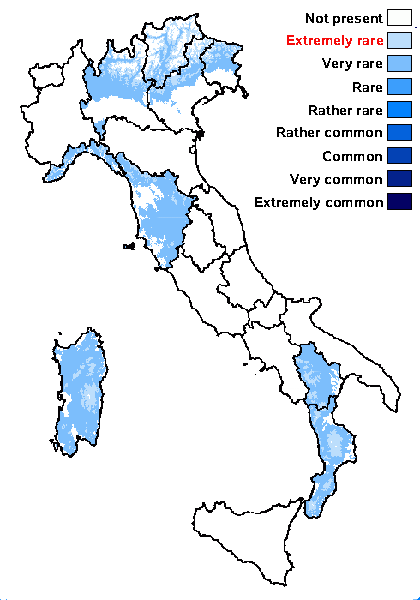
Predictive model
Herbarium samples
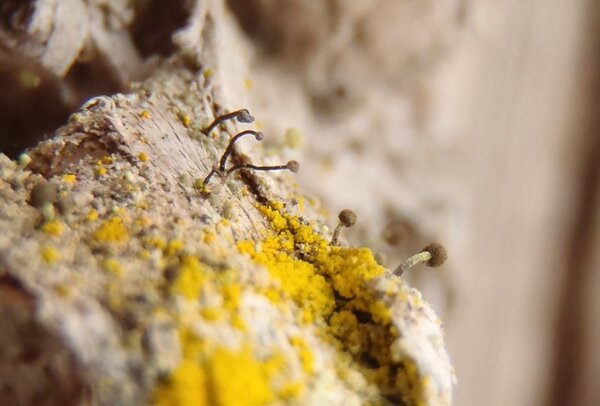

Curtis Randall Björk – CC BY-SA 4.0
British Columbia, Clearwater Valley Date: 2014-05-04 Corticolous, trunk of large Populus trichocarpa in humid old-growth forest
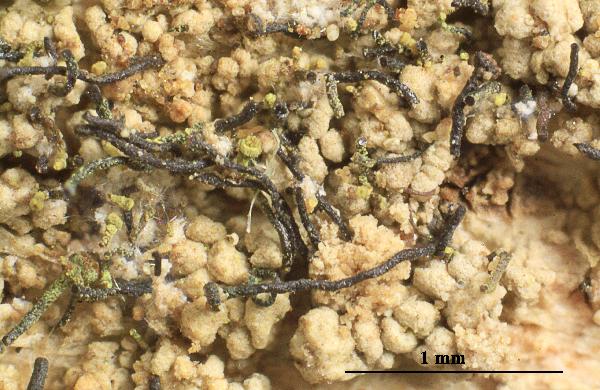

Felix Schumm - CC BY-SA 4.0
[VZR196], Bohemia merid., montes Šumava, distr. Klatrovy, Modrava, in monte "Smrkový vrch", 1100 m. Ad corticem arborum (Acer pseudoplatanus). Leg. Z. Palice & A. Vezda. EX A. VEZDA: LICHENES RARIORES EXSICCATI NR. 196.
Growth form: Crustose
Substrata: bark and lignum
Photobiont: green algae other than Trentepohlia
Reproductive strategy: mainly sexual
In underhangs rarely wetted by rain
Commonnes-rarity: (info)
Alpine belt: absent
Subalpine belt: absent
Oromediterranean belt: absent
Montane belt: extremely rare
Submediterranean belt: very rare
Padanian area: absent
Humid submediterranean belt: very rare
Humid mediterranean belt: absent
Dry mediterranean belt: absent

Predictive model
| Herbarium samples |


Curtis Randall Björk – CC BY-SA 4.0
British Columbia, Clearwater Valley Date: 2014-05-04 Corticolous, trunk of large Populus trichocarpa in humid old-growth forest


 INDEX FUNGORUM
INDEX FUNGORUM
 GBIF
GBIF
 DOLICHENS
DOLICHENS
